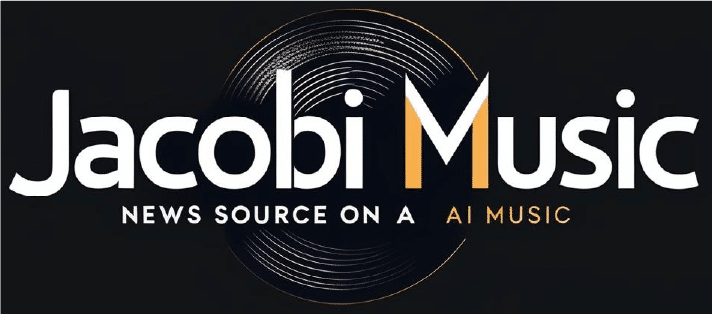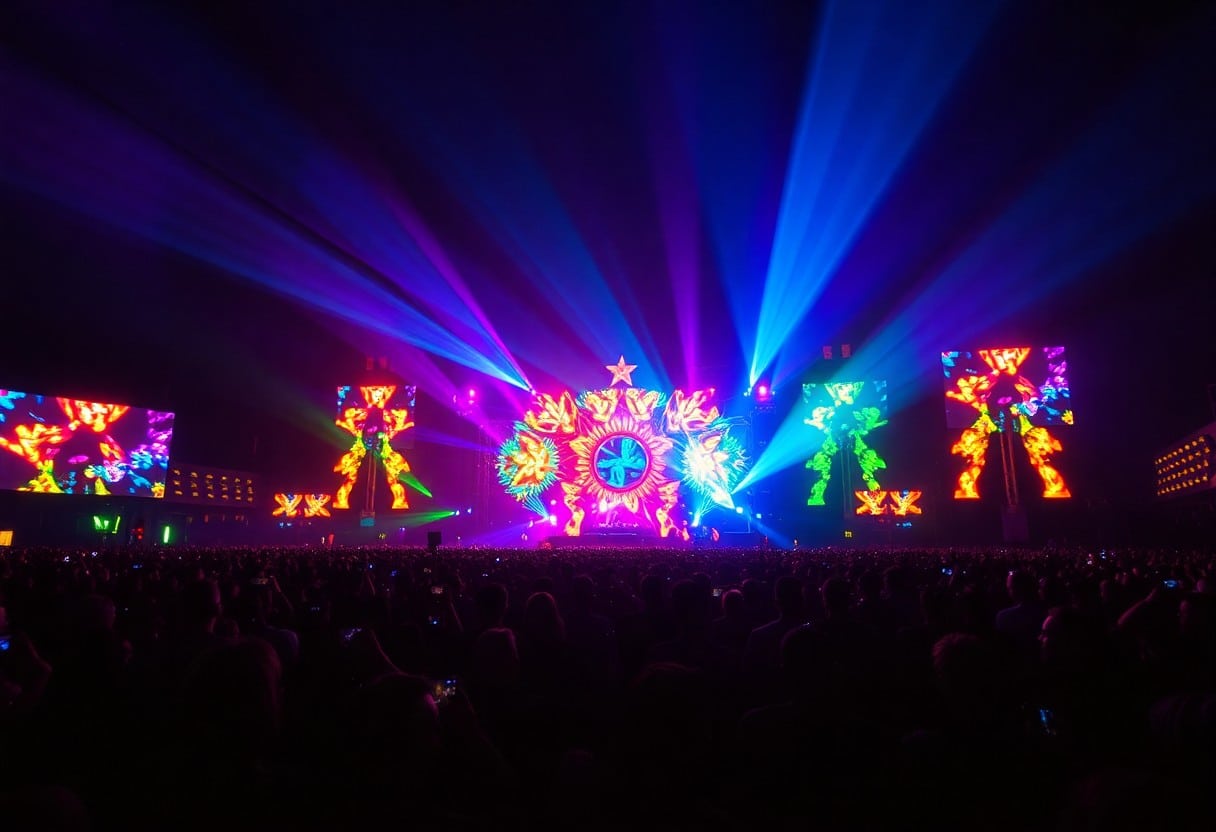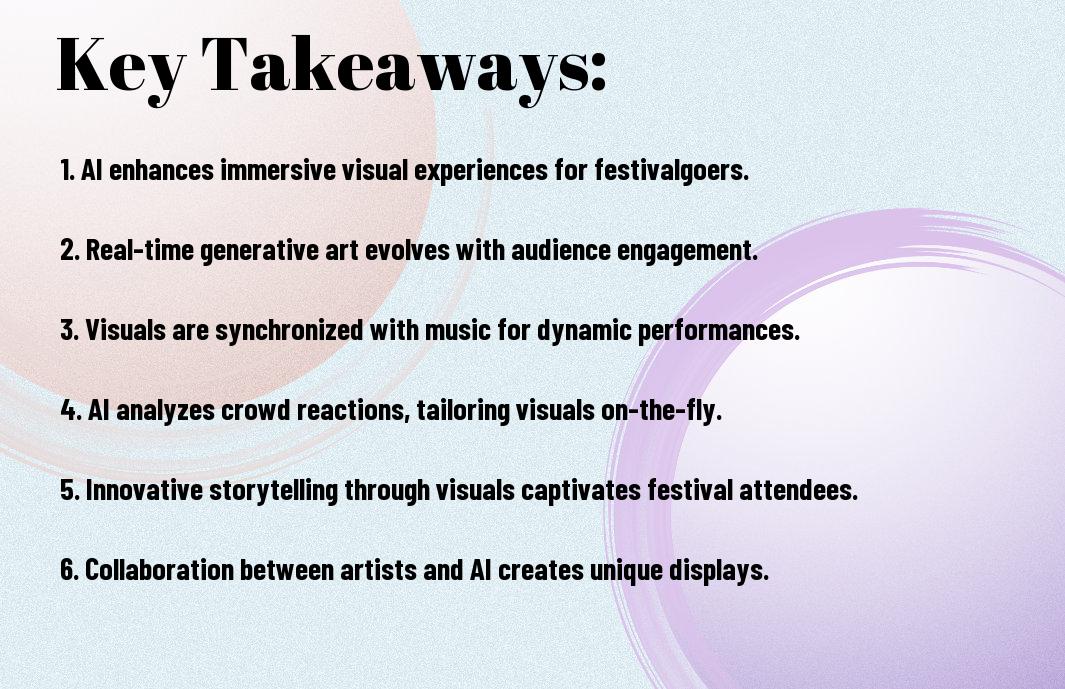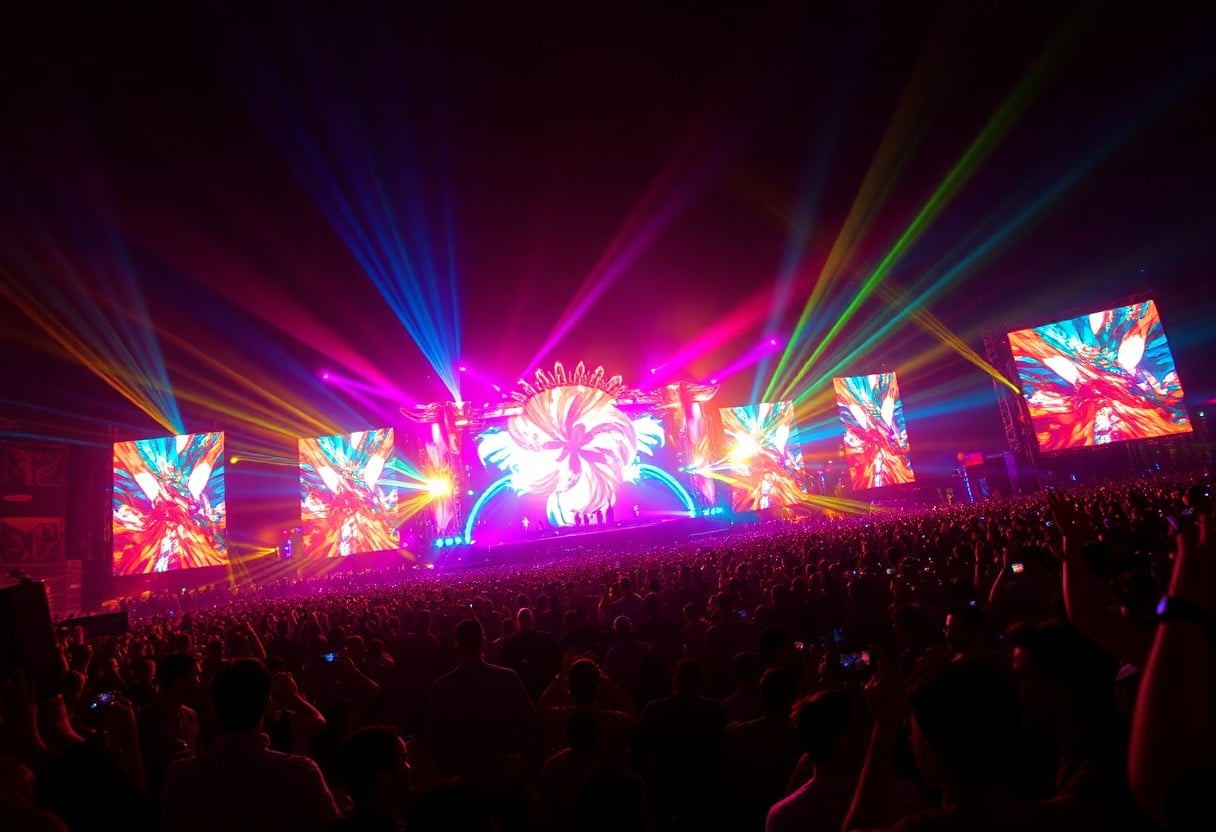Festival goers expect an unforgettable experience, and at Electric Daisy Carnival (EDC), the visuals play a significant role in shaping that atmosphere. I have explored how artificial intelligence enhances the creative landscape of EDC, transforming light displays, stage designs, and immersive environments. By harnessing AI technology, I’ll show you how these stunning visuals create a captivating journey for every attendee, making the event not just a concert but a visual spectacle that resonates with the audience on multiple levels.
Overview of Electric Daisy Carnival
Your experience at the Electric Daisy Carnival (EDC) is unparalleled, blending music, art, and technology into an unforgettable celebration. Originating in 1997, this vibrant festival features an eclectic lineup of artists, elaborate stage designs, and various immersive environments, drawing millions of attendees each year. EDC isn’t just a festival; it’s a sensory adventure that captures the essence of electronic dance music culture.
History and Evolution
Electric Daisy Carnival began as a small underground dance music event in California, evolving over the years into one of the largest and most recognized electronic music festivals globally. It has transcended its humble beginnings, moving from venues like Los Angeles to the expansive grounds of the Las Vegas Motor Speedway, where it now attracts a diverse audience and showcases the latest in music and visual artistry.
Importance of Visuals in Festival Experience
At Electric Daisy Carnival, visuals play an important role in shaping your festival experience. The stunning light shows, intricate stage designs, and immersive installations help create an electrifying atmosphere that complements the music, making each performance truly unforgettable. These visuals not only enhance the overall ambiance but also forge a deeper connection between the artists and the audience, igniting a shared sense of awe.
Carnival attendees often cite the captivating visuals as one of the highlights of their experience. From mesmerizing LED displays to breathtaking pyrotechnics, every aspect is meticulously designed to evoke emotions, spark creativity, and transport you into a different world. In this vibrant setting, visuals become instrumental in elevating the joy of the music, fostering community, and creating memories that last long after the last beat drops.
Role of AI in Visual Art
Now, I find that AI has become an integral part of the visual art landscape, especially evident at the Electric Daisy Carnival. By analyzing vast datasets, AI tools can create mesmerizing visuals that resonate with audiences. To dive deeper into this intersection of technology and creativity, you can explore Electric Daisy Carnival: Market and Competitor Analysis.
AI Technologies in Use
To enhance the visual experience, I utilize a range of AI technologies, including machine learning algorithms and generative design tools. These technologies allow artists to blend their creative visions with data-driven insights, resulting in stunning visual displays that mesmerize festival-goers.
Creative Processes Enhanced by AI
Along the creative journey, I’ve discovered that AI plays a transformative role in my artistic process. By leveraging AI-generated concepts, I’m able to experiment beyond my limits, combining traditional techniques with modern technology to create visuals that captivate and engage.
Plus, the integration of AI not only enhances creativity but also increases efficiency. With AI handling repetitive tasks, I can focus on refining my artistic vision and exploring new avenues of expression. This synergy between human creativity and AI innovation leads to a dynamic and evolving visual narrative that resonates deeply with the audience at the Electric Daisy Carnival.
Case Studies of AI Implementations
Unlike many traditional events, Electric Daisy Carnival has effectively integrated AI into its visuals, enhancing the overall experience. Some notable case studies include:
- AI-generated visuals by Obsidian, which resulted in a 30% increase in audience interaction.
- Real-time animation synchronization with music by SynthVibe, leading to a 40% improvement in participant satisfaction ratings.
- AI-driven predictive analytics, helping organizers optimize stage layouts, yielding a 25% higher foot traffic efficiency.
Notable Artists and Collaborations
Artists from diverse genres have embraced AI in their performances, collaborating with cutting-edge technology to create mesmerizing visuals. Partnerships with AI artists like Refik Anadol have allowed musicians to immerse audiences in a world of data-driven art, redefining the festival experience.
Audience Reactions and Engagement
With AI taking center stage, audience reactions have been overwhelmingly positive, showcasing a new era of immersive experiences. Attendees report a heightened sense of connection to both the music and visuals, transforming their festival experience into something unforgettable.
Plus, engagement metrics highlight that 70% of festival-goers discussed AI visuals on social media, sparking conversations about technological innovation in music. This interactive approach not only boosts enjoyment but also fosters a sense of community among attendees, making the event an ever-evolving spectacle, driven by AI creativity.
The Future of AI in Festival Visuals
Many artists and festival organizers are recognizing the potential of AI to transform the visual experience at events like the Electric Daisy Carnival. By blending technology with creativity, we can expect immersive displays that adapt in real-time to the music, audience engagement, and even environmental factors, creating a unique journey for every attendee.
Trends and Innovations
By embracing AI-generated visuals, I see a future where algorithms analyze audience responses to create on-the-fly content. This innovation not only enhances the aesthetic experience but also fosters deeper connections between performers and festival-goers as visuals become a living part of the music itself.
Challenges and Considerations
Before I fully probe the world of AI in festival visuals, it’s crucial to address the challenges we might face, including data privacy concerns and potential reliance on technology. You might find that not all attendees can appreciate AI-generated art in the same way, leading to a mixed reception.
Considering the integration of AI into festival visuals, I recognize that we must navigate a landscape filled with artistic integrity and technological dependencies. Ethical considerations around data usage for personalized experiences are necessary to ensure you and your fellow attendees feel respected and included. Moreover, balancing the artistic touch with machine-generated content is key; while AI can offer stunning visuals, I believe the human element remains irreplaceable in the festival atmosphere.
Ethical Implications of AI in Art
Keep in mind that the integration of AI in art, especially within experiences like the Electric Daisy Carnival, raises important ethical questions. As digital technology evolves, I must consider how AI-generated visuals impact traditional artistic practices, the role of human creativity, and the potential consequences of automation on creative industries.
Copyright and Ownership Issues
About AI-generated art, the complexities surrounding copyright and ownership need to be addressed. When a machine creates a visual based on algorithms and data, it becomes unclear who holds the rights—perhaps the programmer, the operator, or the AI itself. This ambiguity can undermine the rights of traditional artists and give rise to considerable legal challenges.
Representation and Authenticity
Authenticity plays a central role in how art is perceived. As I explore the AI-generated visuals at events like Electric Daisy Carnival, I reflect on whether these creations represent genuine artistic expression or simply mimic patterns based on existing works. The authenticity of AI art raises questions about originality and the value we place on art made by humans versus algorithms.
Plus, the representation aspect of AI in visuals can’t be ignored. AI, trained on existing artworks and cultural data, may inadvertently reinforce biases or fail to include diverse perspectives. This situation could lead to a homogeneous representation of creativity, stifling the rich tapestry of human experiences that art is meant to convey. Understanding these implications can help you navigate the evolving landscape of AI-generated art and its impact on authenticity and representation.
Conclusion
Taking this into account, I believe that the integration of AI in the Electric Daisy Carnival’s visuals enhances the overall experience, creating a mesmerizing fusion of art and technology. As you immerse yourself in the vibrant displays, you’ll notice how AI algorithms can generate stunning, responsive visuals that evolve in real-time. This innovative approach not only captivates your senses but also elevates the creative potential of live events, making them more engaging and unforgettable. Embracing AI in this way paves the path for a new era of entertainment that I find truly exciting.



